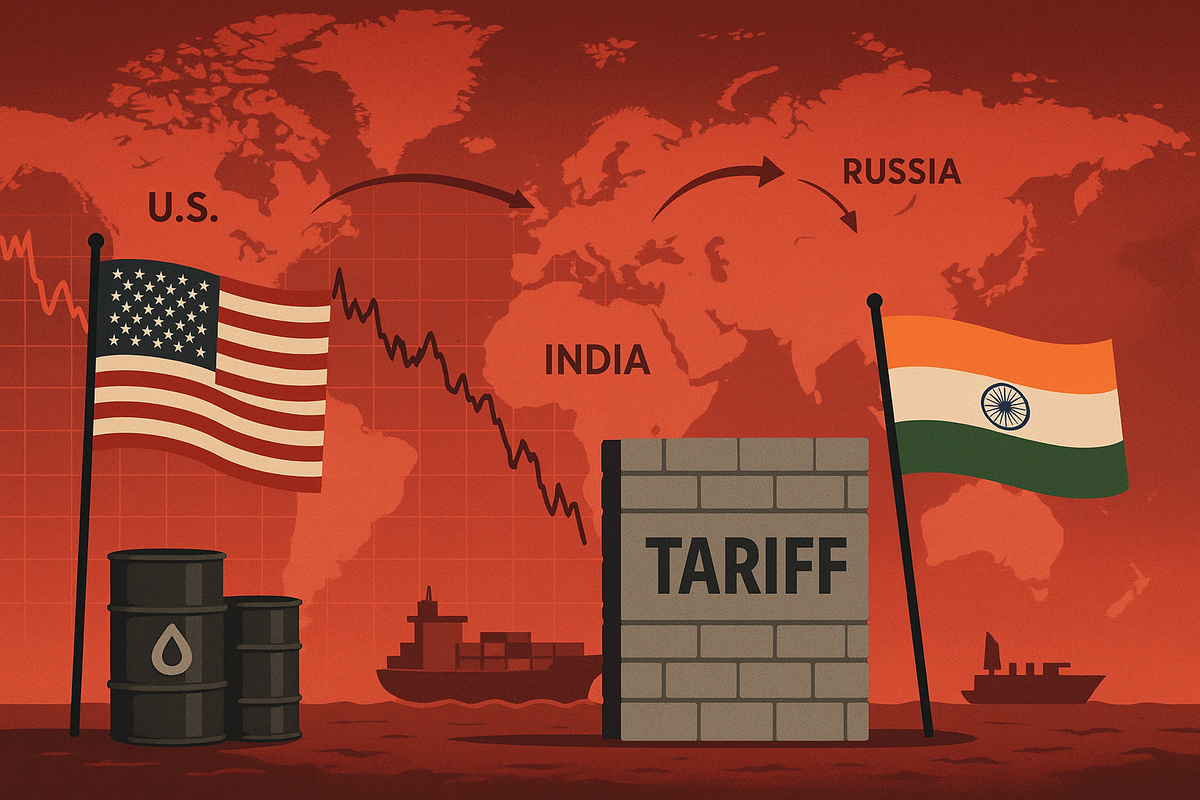
President Donald Trump's recent imposition of significantly higher import taxes has sent a tremor through the global financial landscape, ushering in an era of heightened economic uncertainty. The most immediate and striking impact has been felt in India, where tariffs on its exports have surged to an unprecedented 50%. This drastic measure is a direct retaliation for India's continued oil trade with Russia, a move the U.S. views as undermining efforts to curb Russia's war machine. The repercussions have been swift and severe, with India's benchmark stock indices, the Sensex and Nifty, experiencing sharp declines, signaling deep investor apprehension.
This aggressive tariff policy, a hallmark of Trump's "America First" approach, aims to reshape global trade dynamics and prioritize domestic manufacturing. However, its unpredictable nature has created a volatile environment, forcing nations and industries worldwide to re-evaluate their trade strategies and brace for potential economic headwinds.
Escalating Trade Tensions: India Caught in the Crosshairs
The escalation of tariffs against India is a direct consequence of its ongoing purchases of Russian oil. The Trump administration has explicitly stated that these transactions are "fueling the war machine" in the Ukraine conflict, leading to a punitive 50% tariff on Indian goods. This comprises an initial 25% tariff that took effect on August 7, 2025, followed by an additional 25% duty commencing on August 27, bringing the total to a staggering 50%.
This substantial increase in import duties is projected to significantly inflate the cost of Indian products in the U.S. market, rendering them less competitive and potentially leading to a 40-50% decline in India's exports to the United States. The move has particularly devastated labor-intensive Indian industries. Key sectors facing the brunt of these tariffs include:
- Textiles and Apparel: Expected to face substantial challenges, with woven and knitted apparel potentially facing import duties as high as 63.9%.
- Gems and Jewellery: Heavily reliant on U.S. exports, this sector is predicted to experience significant losses, with duties around 52.1%.
- Seafood (especially shrimp): The industry faces a potential loss of Rs 24,000 crore (approximately $2.9 billion USD) due to the doubled tariffs, putting India at a disadvantage compared to competitors like Ecuador.
- Leather and Footwear: Also among the most affected export-oriented sectors.
- Chemicals and Auto Components: These sectors are also expected to be significantly impacted.
The tariffs have immediately soured market sentiment in India. On August 7, the BSE Sensex (BOM:532540) fell 527 points during intra-day trade, and the NSE Nifty (NSE:NIFTY) fell by 170 points. The following day, August 8, Indian stocks ended in deep red, with the Sensex falling 765.47 points (0.95%) to close at 79,857.79, and the Nifty shedding 232.85 points (0.95%) to trade at 24,363.30. This marked their sixth consecutive weekly loss, attributed to the abrupt doubling of tariffs, persistent foreign institutional investor (FII) outflows, and subdued Q1 earnings. Foreign Institutional Investors (FIIs) have been in a selling mode for multiple consecutive sessions, recording significant outflows.
Winners and Losers in a Tariff-Driven Landscape
In this new tariff-laden environment, the clear losers are numerous Indian export-oriented industries and the companies operating within them. The 50% tariff makes Indian goods prohibitively expensive for American consumers and businesses, directly impacting the revenue and profitability of Indian exporters. Companies in the textile and apparel sector, such as Arvind Limited (NSE:ARVIND) or Raymond Limited (NSE:RAYMOND), which have significant export operations to the U.S., are likely to see a sharp decline in orders and revenue. Similarly, gems and jewellery exporters, including Titan Company Limited (NSE:TITAN), will face immense pressure on their U.S. sales.
The seafood industry, particularly shrimp exporters like Avanti Feeds Limited (NSE:AVANTIFEED), stands to lose billions of rupees as their products become uncompetitive against those from countries not subject to such high tariffs. The leather and footwear sector, with companies like Bata India Limited (NSE:BATAINDIA) and Mirza International Limited (NSE:MIRZAINT), will also struggle to maintain their market share in the U.S. The broader impact on the Indian economy is projected to be significant, with analysts estimating a cumulative downside of 0.6% to India's real GDP growth, and some projections suggesting a slowdown of 0.3 to 0.8 percentage points if the tariffs persist.
While the immediate losers are evident, the "winners" in such a scenario are less clear-cut. The stated aim of Trump's tariffs is to promote domestic manufacturing in the U.S. Theoretically, American companies in sectors that compete with Indian imports, such as U.S. textile manufacturers or seafood producers, might see an increase in demand. However, the overall economic uncertainty and potential for retaliatory tariffs from other nations could dampen any potential gains. Furthermore, American consumers are likely to face higher prices for goods that were previously imported from India, effectively making them "losers" in terms of purchasing power.
Broader Implications and Global Economic Uncertainty
President Trump's tariff policy, characterized by an "America First" approach, aims to reduce trade deficits and promote domestic manufacturing. However, these policies have created significant economic policy uncertainty globally, which generally depresses economic activity by prompting firms and households to postpone investment, hiring, and consumption decisions. The Economic Policy Uncertainty (EPU) Index reached its highest point since the beginning of the COVID-19 pandemic by the end of March 2025, doubling in value from January, and is projected to reduce investment by about 4.4% in 2025.
The broader implications of such unpredictable tariff policies extend far beyond India:
- Direct Tax on Imported Goods: Tariffs act as a direct tax on imported goods, which can lead to higher prices for consumers. Nearly 8 in 10 Americans are concerned that Trump's tariffs will raise prices on everyday goods.
- Reduction in Imported Goods and Capital Flows: A reduction in imported goods means foreign businesses and governments may purchase fewer U.S. assets, including federal government bonds, impacting capital flows.
- Negative Impact on GDP and Wages: The Penn Wharton Budget Model projects that Trump's tariffs (as of April 8, 2025) could reduce long-run U.S. GDP by about 6% and wages by 5%, with a middle-income household facing a $22,000 lifetime loss. Other analyses suggest a 1.3% reduction in long-run economic output before foreign retaliation.
- Disruption of Global Supply Chains: The policies have made the investment landscape more unpredictable, prompting analysts to advise investors to adopt more flexible strategies. Global trading partners are struggling to adjust, which may disrupt supply chains.
- Strained International Trade Relations: The imposition of tariffs has led to strained relations with trading partners, as seen in the case of India. Trump has also proposed tariffs as high as 60% on China and 25% on Canada and Mexico, and a universal 10% tariff on all other countries.
- Reduced Effectiveness of Macroeconomic Policy: When uncertainty shocks cause recessions, standard macroeconomic policy measures like monetary easing and fiscal policy may be less effective.
Historically, trade wars have often led to negative outcomes for all parties involved, as seen during the Great Depression with the Smoot-Hawley Tariff Act. While proponents argue that tariffs can reduce trade deficits and promote domestic manufacturing, critics highlight the potential for higher inflation, legal disputes, and a dampening effect on consumer confidence and spending.
What Comes Next: Navigating the Uncharted Waters
In the short term, India's foreign ministry has called the decision "extremely unfortunate" and stated that New Delhi will take all necessary actions to protect its national interests. The Indian government is exploring measures, including a Rs 20,000 crore export promotion mission, to diversify export options and cushion the impact on the industry. Indian companies will need to rapidly pivot their export strategies, seeking new markets beyond the U.S. and potentially re-evaluating their production processes to reduce reliance on U.S. demand. This could involve increased focus on domestic consumption or exploring trade agreements with other nations.
In the long term, the global trade landscape is likely to become more fragmented and regionalized. Nations may seek to strengthen bilateral trade agreements and diversify their supply chains to reduce vulnerability to unilateral tariff actions. This could lead to a re-shoring or near-shoring of manufacturing for some industries, as companies prioritize supply chain resilience over cost efficiency. For investors, this means adopting more flexible and diversified portfolios, with a keen eye on geopolitical developments and their potential impact on specific sectors and companies. Market opportunities may emerge in countries or regions that are less exposed to these trade tensions, or in industries that can adapt quickly to changing trade flows.
Potential scenarios include a prolonged period of trade disputes, leading to a slowdown in global economic growth, or a eventual de-escalation if political dynamics shift. However, the unpredictable nature of the current tariff policy suggests that volatility will remain a key feature of the financial markets for the foreseeable future.
Conclusion: A New Era of Trade Volatility
The imposition of steep tariffs on Indian exports by the U.S. marks a significant turning point in global trade relations, highlighting the increasing weaponization of economic policy. The immediate impact on India's stock markets and its export-oriented industries underscores the vulnerability of nations heavily reliant on specific trade partners. This event serves as a stark reminder of the interconnectedness of the global economy and how unilateral actions can trigger widespread ripple effects.
Moving forward, investors should brace for continued volatility and uncertainty. Key takeaways include the need for diversification in investment portfolios, a focus on companies with robust domestic markets or diversified export bases, and a close watch on geopolitical developments. The lasting impact of these tariffs could reshape global supply chains, accelerate the trend towards regional trade blocs, and fundamentally alter the dynamics of international commerce. The coming months will be crucial in determining whether this marks a temporary blip or the beginning of a more protectionist and fragmented global economic order.






